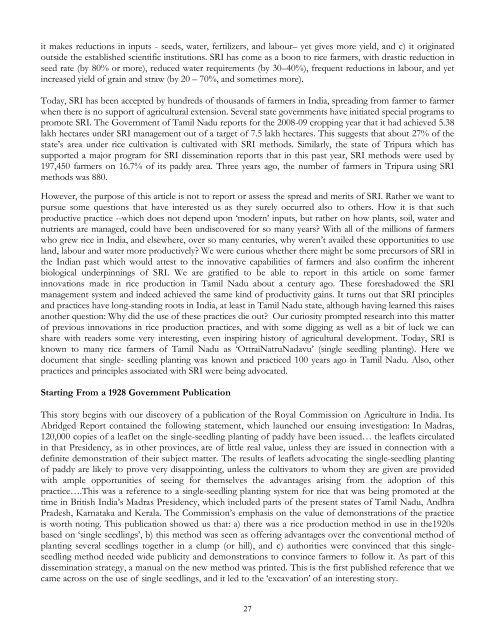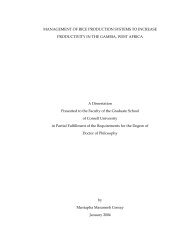Revised proceedings - The System of Rice Intensification - Cornell ...
Revised proceedings - The System of Rice Intensification - Cornell ...
Revised proceedings - The System of Rice Intensification - Cornell ...
You also want an ePaper? Increase the reach of your titles
YUMPU automatically turns print PDFs into web optimized ePapers that Google loves.
it makes reductions in inputs - seeds, water, fertilizers, and labour– yet gives more yield, and c) it originated<br />
outside the established scientific institutions. SRI has come as a boon to rice farmers, with drastic reduction in<br />
seed rate (by 80% or more), reduced water requirements (by 30–40%), frequent reductions in labour, and yet<br />
increased yield <strong>of</strong> grain and straw (by 20 – 70%, and sometimes more).<br />
Today, SRI has been accepted by hundreds <strong>of</strong> thousands <strong>of</strong> farmers in India, spreading from farmer to farmer<br />
when there is no support <strong>of</strong> agricultural extension. Several state governments have initiated special programs to<br />
promote SRI. <strong>The</strong> Government <strong>of</strong> Tamil Nadu reports for the 2008-09 cropping year that it had achieved 5.38<br />
lakh hectares under SRI management out <strong>of</strong> a target <strong>of</strong> 7.5 lakh hectares. This suggests that about 27% <strong>of</strong> the<br />
state‟s area under rice cultivation is cultivated with SRI methods. Similarly, the state <strong>of</strong> Tripura which has<br />
supported a major program for SRI dissemination reports that in this past year, SRI methods were used by<br />
197,450 farmers on 16.7% <strong>of</strong> its paddy area. Three years ago, the number <strong>of</strong> farmers in Tripura using SRI<br />
methods was 880.<br />
However, the purpose <strong>of</strong> this article is not to report or assess the spread and merits <strong>of</strong> SRI. Rather we want to<br />
pursue some questions that have interested us as they surely occurred also to others. How it is that such<br />
productive practice --which does not depend upon „modern‟ inputs, but rather on how plants, soil, water and<br />
nutrients are managed, could have been undiscovered for so many years? With all <strong>of</strong> the millions <strong>of</strong> farmers<br />
who grew rice in India, and elsewhere, over so many centuries, why weren‟t availed these opportunities to use<br />
land, labour and water more productively? We were curious whether there might be some precursors <strong>of</strong> SRI in<br />
the Indian past which would attest to the innovative capabilities <strong>of</strong> farmers and also confirm the inherent<br />
biological underpinnings <strong>of</strong> SRI. We are gratified to be able to report in this article on some farmer<br />
innovations made in rice production in Tamil Nadu about a century ago. <strong>The</strong>se foreshadowed the SRI<br />
management system and indeed achieved the same kind <strong>of</strong> productivity gains. It turns out that SRI principles<br />
and practices have long-standing roots in India, at least in Tamil Nadu state, although having learned this raises<br />
another question: Why did the use <strong>of</strong> these practices die out? Our curiosity prompted research into this matter<br />
<strong>of</strong> previous innovations in rice production practices, and with some digging as well as a bit <strong>of</strong> luck we can<br />
share with readers some very interesting, even inspiring history <strong>of</strong> agricultural development. Today, SRI is<br />
known to many rice farmers <strong>of</strong> Tamil Nadu as „OttraiNatruNadavu‟ (single seedling planting). Here we<br />
document that single- seedling planting was known and practiced 100 years ago in Tamil Nadu. Also, other<br />
practices and principles associated with SRI were being advocated.<br />
Starting From a 1928 Government Publication<br />
This story begins with our discovery <strong>of</strong> a publication <strong>of</strong> the Royal Commission on Agriculture in India. Its<br />
Abridged Report contained the following statement, which launched our ensuing investigation: In Madras,<br />
120,000 copies <strong>of</strong> a leaflet on the single-seedling planting <strong>of</strong> paddy have been issued… the leaflets circulated<br />
in that Presidency, as in other provinces, are <strong>of</strong> little real value, unless they are issued in connection with a<br />
definite demonstration <strong>of</strong> their subject matter. <strong>The</strong> results <strong>of</strong> leaflets advocating the single-seedling planting<br />
<strong>of</strong> paddy are likely to prove very disappointing, unless the cultivators to whom they are given are provided<br />
with ample opportunities <strong>of</strong> seeing for themselves the advantages arising from the adoption <strong>of</strong> this<br />
practice….This was a reference to a single-seedling planting system for rice that was being promoted at the<br />
time in British India‟s Madras Presidency, which included parts <strong>of</strong> the present states <strong>of</strong> Tamil Nadu, Andhra<br />
Pradesh, Karnataka and Kerala. <strong>The</strong> Commission‟s emphasis on the value <strong>of</strong> demonstrations <strong>of</strong> the practice<br />
is worth noting. This publication showed us that: a) there was a rice production method in use in the1920s<br />
based on „single seedlings‟, b) this method was seen as <strong>of</strong>fering advantages over the conventional method <strong>of</strong><br />
planting several seedlings together in a clump (or hill), and c) authorities were convinced that this singleseedling<br />
method needed wide publicity and demonstrations to convince farmers to follow it. As part <strong>of</strong> this<br />
dissemination strategy, a manual on the new method was printed. This is the first published reference that we<br />
came across on the use <strong>of</strong> single seedlings, and it led to the „excavation‟ <strong>of</strong> an interesting story.<br />
27

















